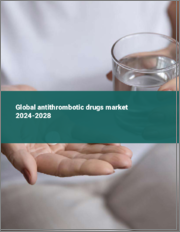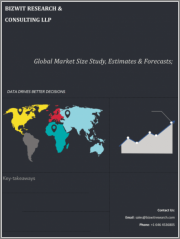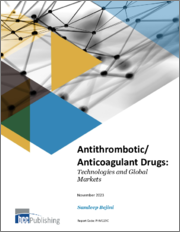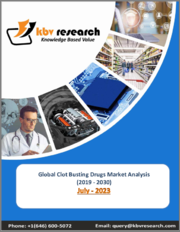
|
시장보고서
상품코드
1344345
혈전용해제 시장 : 제품별, 적응증별, 투여 경로별, 유통 채널별 - 세계 기회 분석 및 산업 예측(2023-2032년)Clot Busting Drugs Market By Product, By Indication, By Route of Administration, By Distribution Channel : Global Opportunity Analysis and Industry Forecast, 2023-2032 |
||||||
Allied Market Research가 발행한 새로운 보고서에 따르면 혈전용해제 시장은 2022년 286억 달러로 평가되며 2023년부터 2032년까지 CAGR 8.2%로 성장해 2032년에는 600억 달러에 달할 것으로 추정됩니다.
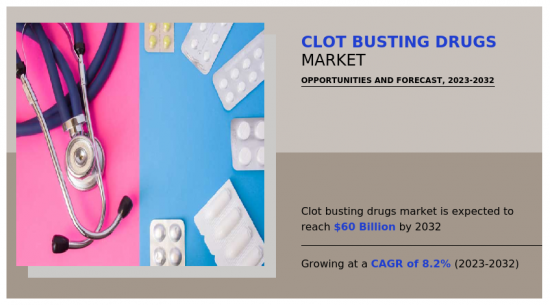
혈전용해제는 혈전 파괴제 또는 섬유소 용해제라고도 하며, 혈전증이라는 병적 상태의 혈전을 용해시키는 데 사용되는 약물입니다. 혈전증은 혈관에 혈전이 형성되어 혈액의 흐름을 방해하여 발생하며, TPA는 뇌로 가는 혈류를 차단하거나 방해하는 혈전을 파괴하는 데 사용되는 혈전용해제 또는 혈전 파괴 약물로 뇌의 영향을 받는 부위로의 혈류 회복을 돕습니다. 헤파린, 와파린, 다비가트란, 아픽사반, 리바록사반 등의 항응고제는 혈액을 묽게 만들어 혈전을 녹이는 데 도움을 주는 약물입니다.
심혈관 질환의 치료 가이드라인은 특정 질환에서 혈전용해제를 자주 사용하도록 권고하고 있습니다. 진단 방법이 개선되고 심혈관 질환의 징후와 증상에 대한 인식이 높아짐에 따라 조기 발견과 조기 치료가 가능해졌습니다. 미래의 위험을 예방하기 위해 조기 개입에는 일반적으로 혈전용해제 사용이 포함됩니다. 전반적으로 심혈관 질환의 유병률 증가는 치료 옵션에 대한 혁신과 인식의 증가와 함께 혈전용해제에 대한 수요를 증가시키고 있습니다.
소변이나 대변의 비정상적인 출혈, 상처나 상처로 인한 과도한 출혈, 혈전용해제에 대한 알레르기 반응, 저혈압, 혈전용해제의 기타 부작용으로 인해 주의 깊게 감독해야 합니다. 드물게 혈전용해제를 사용하지 않고 혈전을 조절할 수 있는 다른 방법이 있을 수 있습니다. 예를 들어, 심부정맥혈전증이나 폐색전증의 경우 항응고제(헤파린이나 직접 경구용 항응고제 등)가 주요 치료제로 사용될 수 있습니다. 보완 요법의 가용성은 혈전용해제에 대한 수요에 영향을 미칠 수 있습니다.
혈전용해제 시장의 확대는 경제 성장, 의료 보장 범위 확대, 의료 인식 증가 등 다양한 요인으로 인해 발생합니다. 의료비 지출이 증가함에 따라 혈전용해제는 더 저렴하고 쉽게 구할 수 있게 되어 수요가 증가합니다. 혈전용해제의 효능과 안전성을 평가하기 위한 지속적인 연구와 임상시험이 시장 확대를 촉진하고 있습니다. 의료 인프라가 개선되고 다양한 지역에서 혈전증에 대한 인식이 높아짐에 따라 효과적인 혈전용해제에 대한 수요가 증가하고 있습니다. 제약사들은 저렴한 가격과 접근성이 좋은 치료법을 제공함으로써 이 시장을 발전시킬 수 있습니다.
COVID-19는 혈전용해제 시장을 포함한 의료의 많은 부분에 큰 영향을 미치고 있으며, COVID-19는 주로 호흡기 계통에 영향을 미치지만 다양한 심혈관계 질환을 유발할 수 있어 혈전용해제 수요와 사용에 영향을 미칠 수 있습니다. COVID-19는 심부정맥혈전증(DVT), 폐색전증, 뇌졸중과 같은 장애를 유발할 수 있는 혈전 형성의 높은 위험과 관련이 있습니다. 연구들은 COVID-19와 관련된 혈전 형성 문제에 대해 혈전용해제를 포함한 다양한 항응고제의 효능을 연구하고 있습니다. 이러한 연구는 팬데믹 이후 시장 역학 및 임상 실습에 영향을 미칠 것으로 예상됩니다.
목차
제1장 서론
제2장 주요 요약
제3장 시장 개요
- 시장 정의와 범위
- 주요 조사 결과
- 영향요인
- 주요 투자 기회
- Porter's Five Forces 분석
- 시장 역학
- 성장 촉진요인
- 성장 억제요인
- 기회
- COVID-19 : 시장에 대한 영향 분석
- 평균판매가격
- 시장 점유율 분석
- 브랜드 점유율 분석
- 밸류체인 분석
- 주요 규제 분석
- 특허 상황
- 규제 가이드라인
- 무역 데이터 분석
제4장 혈전용해제 시장 : 제품별
- 개요
- 혈전용해제
- 항혈소판제
- 항응고제
- 기타
제5장 혈전용해제 시장 : 적응증별
- 개요
- 폐색전증
- 심부정맥혈전증
- 심방세동
- 기타
제6장 혈전용해제 시장 : 투여 경로별
- 개요
- 경구
- 주사
제7장 혈전용해제 시장 : 유통 채널별
- 개요
- 병원 약국
- 온라인 약국
- 소매 약국
제8장 혈전용해제 시장 : 지역별
- 개요
- 북미
- 미국
- 캐나다
- 멕시코
- 유럽
- 독일
- 영국
- 프랑스
- 스페인
- 이탈리아
- 기타 유럽
- 아시아태평양
- 중국
- 일본
- 인도
- 한국
- 호주
- 기타 아시아태평양
- 라틴아메리카, 중동 및 아프리카
- 브라질
- 사우디아라비아
- 아랍에미리트
- 남아프리카공화국
- 기타 라틴아메리카, 중동 및 아프리카
제9장 경쟁 상황
- 서론
- 주요 성공 전략
- 주요 10개 기업의 제품 매핑
- 경쟁 대시보드
- 경쟁 히트맵
- 주요 기업의 포지셔닝, 2022년
제10장 기업 개요
- Pfizer Inc.
- Johnson & Johnson Services Inc
- Sanofi
- Dr. Reddy's Laboratories
- Bayer AG
- Boehringer Ingelheim Gmbh
- Genentech Inc.
- Eli Lilly and Company
- Sun Pharmaceutical Industries Ltd.
- Merck & Co
According to a new report published by Allied Market Research, titled, "Clot Busting Drugs Market," The clot busting drugs market was valued at $28.6 billion in 2022, and is estimated to reach $60 billion by 2032, growing at a CAGR of 8.2% from 2023 to 2032.

Clot-busting drugs, also known as thrombolytic agents or fibrinolytic drugs, are medications used to dissolve blood clots in a medical condition called thrombosis. Thrombosis occurs when a blood clot forms within a blood vessel, obstructing the flow of blood. TPA is a thrombolytic or clot buster drug which is used to break up the clot that is causing a blockage or disruption in the flow of blood to the brain and aids in the restoration of blood flow to the affected part of the brain. Anticoagulants, such as heparin, warfarin, dabigatran, apixaban, and rivaroxaban, are medications that thin the blood and help to dissolve blood clots.
Treatment guidelines for cardiovascular disorders frequently need the use of clot-busting medicines in specific conditions.. Improved diagnostic procedures and increased awareness of the signs and symptoms of cardiovascular illnesses have resulted in earlier detection and treatment. To prevent harm in the future, early intervention typically includes the use of clot-busting medications. Overall, the rising prevalence of cardiovascular disorders, combined with innovations in treatment choices and increasing awareness, is boosting demand for clot busting drugs.
Careful and supervised administration is required due to unusual bleeding in the urine or stool, excessive bleeding from wounds or cuts, allergic reactions to clot buster medications, low blood pressure, and other side effects of clot busting medications. There may rarely be other options for controlling blood clots without the use of clot-busting drugs. For instance, in some situations of thrombosis of the deep veins or pulmonary embolism, anticoagulant medications (such as heparin or direct oral anticoagulants) may be used as the primary treatment. The availability of complementary therapies can affect the demand for clot-busting drugs.
The clot busting drugs market expansion is driven by various factors such as economic growth, increase in healthcare coverage, and rise in healthcare awareness. With increased healthcare spending, clot buster medications become more affordable and accessible, resulting in an increase in demand. Ongoing research and clinical trials to assess the efficacy and safety of clot buster medicines boosts the market expansion. As healthcare infrastructure improves and awareness of thrombotic disorders increases in various regions, there is a rising need for effective clot buster drugs. Pharmaceutical companies can tap into these markets by offering affordable and accessible treatment options.
The COVID-19 pandemic has had a substantial impact on many parts of healthcare, including the market for clot busting drugs. While COVID-19 predominantly affects the respiratory system, it can also cause a variety of cardiovascular problems, which may influence the demand for and use of clot-busting medications. COVID-19 has been linked to a higher risk of blood clot formation, which can result in disorders such as deep vein thrombosis (DVT), pulmonary embolism, and stroke. Studies have examined the effectiveness of different anticoagulant treatments, including clot-busting medications, in treating clotting issues associated with COVID-19. These investigations are expected to have an impact on market dynamics and clinical practices in the post-pandemic period.
The key players profiled in this report include: Pfizer Inc., Johnson & Johnson Services Inc, Sanofi, Dr. Reddy's Laboratories, Bayer AG, Boehringer Ingelheim Gmbh, Genentech Inc., Eli Lilly and Company, Sun Pharmaceutical Industries Ltd., and Merck & Co.
Key Benefits For Stakeholders
- This report provides a quantitative analysis of the market segments, current trends, estimations, and dynamics of the clot busting drugs market analysis from 2022 to 2032 to identify the prevailing clot busting drugs market opportunities.
- The market research is offered along with information related to key drivers, restraints, and opportunities.
- Porter's five forces analysis highlights the potency of buyers and suppliers to enable stakeholders make profit-oriented business decisions and strengthen their supplier-buyer network.
- In-depth analysis of the clot busting drugs market segmentation assists to determine the prevailing market opportunities.
- Major countries in each region are mapped according to their revenue contribution to the global market.
- Market player positioning facilitates benchmarking and provides a clear understanding of the present position of the market players.
- The report includes the analysis of the regional as well as global clot busting drugs market trends, key players, market segments, application areas, and market growth strategies.
Key Market Segments
By Product
- Thrombolytic Drugs
- Anti-Platelet Drugs
- Anticoagulants
- Others
By Indication
- Deep Vein Thrombosis
- Atrial Fibrillation
- Others
- Pulmonary Embolism
By Route of Administration
- Oral
- Injectable
By Distribution Channel
- Hospital Pharmacy
- Online Pharmacy
- Retail Pharmacy
By Region
- North America
- U.S.
- Canada
- Mexico
- Europe
- Germany
- UK
- France
- Spain
- Italy
- Rest of Europe
- Asia-Pacific
- China
- Japan
- India
- South Korea
- Australia
- Rest of Asia-Pacific
- LAMEA
- Brazil
- Saudi Arabia
- United Arab Emirates
- South Africa
- Rest of LAMEA
Key Market Players:
- Bayer AG
- Boehringer Ingelheim Gmbh
- Dr. Reddy's Laboratories
- Eli Lilly and Company
- Genentech Inc.
- Johnson & Johnson Services Inc
- Merck & Co
- Pfizer Inc.
- Sanofi
- Sun Pharmaceutical Industries Ltd.
TABLE OF CONTENTS
CHAPTER 1: INTRODUCTION
- 1.1. Report description
- 1.2. Key market segments
- 1.3. Key benefits to the stakeholders
- 1.4. Research Methodology
- 1.4.1. Primary research
- 1.4.2. Secondary research
- 1.4.3. Analyst tools and models
CHAPTER 2: EXECUTIVE SUMMARY
- 2.1. CXO Perspective
CHAPTER 3: MARKET OVERVIEW
- 3.1. Market definition and scope
- 3.2. Key findings
- 3.2.1. Top impacting factors
- 3.2.2. Top investment pockets
- 3.3. Porter's five forces analysis
- 3.4. Market dynamics
- 3.4.1. Drivers
- 3.4.2. Restraints
- 3.4.3. Opportunities
- 3.5. COVID-19 Impact Analysis on the market
- 3.6. Average Selling Price
- 3.7. Market Share Analysis
- 3.8. Brand Share Analysis
- 3.9. Value Chain Analysis
- 3.10. Key Regulation Analysis
- 3.11. Patent Landscape
- 3.12. Regulatory Guidelines
- 3.13. Trade Data Analysis
CHAPTER 4: CLOT BUSTING DRUGS MARKET, BY PRODUCT
- 4.1. Overview
- 4.1.1. Market size and forecast
- 4.2. Thrombolytic Drugs
- 4.2.1. Key market trends, growth factors and opportunities
- 4.2.2. Market size and forecast, by region
- 4.2.3. Market share analysis by country
- 4.3. Anti-Platelet Drugs
- 4.3.1. Key market trends, growth factors and opportunities
- 4.3.2. Market size and forecast, by region
- 4.3.3. Market share analysis by country
- 4.4. Anticoagulants
- 4.4.1. Key market trends, growth factors and opportunities
- 4.4.2. Market size and forecast, by region
- 4.4.3. Market share analysis by country
- 4.5. Others
- 4.5.1. Key market trends, growth factors and opportunities
- 4.5.2. Market size and forecast, by region
- 4.5.3. Market share analysis by country
CHAPTER 5: CLOT BUSTING DRUGS MARKET, BY INDICATION
- 5.1. Overview
- 5.1.1. Market size and forecast
- 5.2. Pulmonary Embolism
- 5.2.1. Key market trends, growth factors and opportunities
- 5.2.2. Market size and forecast, by region
- 5.2.3. Market share analysis by country
- 5.3. Deep Vein Thrombosis
- 5.3.1. Key market trends, growth factors and opportunities
- 5.3.2. Market size and forecast, by region
- 5.3.3. Market share analysis by country
- 5.4. Atrial Fibrillation
- 5.4.1. Key market trends, growth factors and opportunities
- 5.4.2. Market size and forecast, by region
- 5.4.3. Market share analysis by country
- 5.5. Others
- 5.5.1. Key market trends, growth factors and opportunities
- 5.5.2. Market size and forecast, by region
- 5.5.3. Market share analysis by country
CHAPTER 6: CLOT BUSTING DRUGS MARKET, BY ROUTE OF ADMINISTRATION
- 6.1. Overview
- 6.1.1. Market size and forecast
- 6.2. Oral
- 6.2.1. Key market trends, growth factors and opportunities
- 6.2.2. Market size and forecast, by region
- 6.2.3. Market share analysis by country
- 6.3. Injectable
- 6.3.1. Key market trends, growth factors and opportunities
- 6.3.2. Market size and forecast, by region
- 6.3.3. Market share analysis by country
CHAPTER 7: CLOT BUSTING DRUGS MARKET, BY DISTRIBUTION CHANNEL
- 7.1. Overview
- 7.1.1. Market size and forecast
- 7.2. Hospital Pharmacy
- 7.2.1. Key market trends, growth factors and opportunities
- 7.2.2. Market size and forecast, by region
- 7.2.3. Market share analysis by country
- 7.3. Online Pharmacy
- 7.3.1. Key market trends, growth factors and opportunities
- 7.3.2. Market size and forecast, by region
- 7.3.3. Market share analysis by country
- 7.4. Retail Pharmacy
- 7.4.1. Key market trends, growth factors and opportunities
- 7.4.2. Market size and forecast, by region
- 7.4.3. Market share analysis by country
CHAPTER 8: CLOT BUSTING DRUGS MARKET, BY REGION
- 8.1. Overview
- 8.1.1. Market size and forecast By Region
- 8.2. North America
- 8.2.1. Key trends and opportunities
- 8.2.2. Market size and forecast, by Product
- 8.2.3. Market size and forecast, by Indication
- 8.2.4. Market size and forecast, by Route of Administration
- 8.2.5. Market size and forecast, by Distribution Channel
- 8.2.6. Market size and forecast, by country
- 8.2.6.1. U.S.
- 8.2.6.1.1. Key market trends, growth factors and opportunities
- 8.2.6.1.2. Market size and forecast, by Product
- 8.2.6.1.3. Market size and forecast, by Indication
- 8.2.6.1.4. Market size and forecast, by Route of Administration
- 8.2.6.1.5. Market size and forecast, by Distribution Channel
- 8.2.6.2. Canada
- 8.2.6.2.1. Key market trends, growth factors and opportunities
- 8.2.6.2.2. Market size and forecast, by Product
- 8.2.6.2.3. Market size and forecast, by Indication
- 8.2.6.2.4. Market size and forecast, by Route of Administration
- 8.2.6.2.5. Market size and forecast, by Distribution Channel
- 8.2.6.3. Mexico
- 8.2.6.3.1. Key market trends, growth factors and opportunities
- 8.2.6.3.2. Market size and forecast, by Product
- 8.2.6.3.3. Market size and forecast, by Indication
- 8.2.6.3.4. Market size and forecast, by Route of Administration
- 8.2.6.3.5. Market size and forecast, by Distribution Channel
- 8.3. Europe
- 8.3.1. Key trends and opportunities
- 8.3.2. Market size and forecast, by Product
- 8.3.3. Market size and forecast, by Indication
- 8.3.4. Market size and forecast, by Route of Administration
- 8.3.5. Market size and forecast, by Distribution Channel
- 8.3.6. Market size and forecast, by country
- 8.3.6.1. Germany
- 8.3.6.1.1. Key market trends, growth factors and opportunities
- 8.3.6.1.2. Market size and forecast, by Product
- 8.3.6.1.3. Market size and forecast, by Indication
- 8.3.6.1.4. Market size and forecast, by Route of Administration
- 8.3.6.1.5. Market size and forecast, by Distribution Channel
- 8.3.6.2. UK
- 8.3.6.2.1. Key market trends, growth factors and opportunities
- 8.3.6.2.2. Market size and forecast, by Product
- 8.3.6.2.3. Market size and forecast, by Indication
- 8.3.6.2.4. Market size and forecast, by Route of Administration
- 8.3.6.2.5. Market size and forecast, by Distribution Channel
- 8.3.6.3. France
- 8.3.6.3.1. Key market trends, growth factors and opportunities
- 8.3.6.3.2. Market size and forecast, by Product
- 8.3.6.3.3. Market size and forecast, by Indication
- 8.3.6.3.4. Market size and forecast, by Route of Administration
- 8.3.6.3.5. Market size and forecast, by Distribution Channel
- 8.3.6.4. Spain
- 8.3.6.4.1. Key market trends, growth factors and opportunities
- 8.3.6.4.2. Market size and forecast, by Product
- 8.3.6.4.3. Market size and forecast, by Indication
- 8.3.6.4.4. Market size and forecast, by Route of Administration
- 8.3.6.4.5. Market size and forecast, by Distribution Channel
- 8.3.6.5. Italy
- 8.3.6.5.1. Key market trends, growth factors and opportunities
- 8.3.6.5.2. Market size and forecast, by Product
- 8.3.6.5.3. Market size and forecast, by Indication
- 8.3.6.5.4. Market size and forecast, by Route of Administration
- 8.3.6.5.5. Market size and forecast, by Distribution Channel
- 8.3.6.6. Rest of Europe
- 8.3.6.6.1. Key market trends, growth factors and opportunities
- 8.3.6.6.2. Market size and forecast, by Product
- 8.3.6.6.3. Market size and forecast, by Indication
- 8.3.6.6.4. Market size and forecast, by Route of Administration
- 8.3.6.6.5. Market size and forecast, by Distribution Channel
- 8.4. Asia-Pacific
- 8.4.1. Key trends and opportunities
- 8.4.2. Market size and forecast, by Product
- 8.4.3. Market size and forecast, by Indication
- 8.4.4. Market size and forecast, by Route of Administration
- 8.4.5. Market size and forecast, by Distribution Channel
- 8.4.6. Market size and forecast, by country
- 8.4.6.1. China
- 8.4.6.1.1. Key market trends, growth factors and opportunities
- 8.4.6.1.2. Market size and forecast, by Product
- 8.4.6.1.3. Market size and forecast, by Indication
- 8.4.6.1.4. Market size and forecast, by Route of Administration
- 8.4.6.1.5. Market size and forecast, by Distribution Channel
- 8.4.6.2. Japan
- 8.4.6.2.1. Key market trends, growth factors and opportunities
- 8.4.6.2.2. Market size and forecast, by Product
- 8.4.6.2.3. Market size and forecast, by Indication
- 8.4.6.2.4. Market size and forecast, by Route of Administration
- 8.4.6.2.5. Market size and forecast, by Distribution Channel
- 8.4.6.3. India
- 8.4.6.3.1. Key market trends, growth factors and opportunities
- 8.4.6.3.2. Market size and forecast, by Product
- 8.4.6.3.3. Market size and forecast, by Indication
- 8.4.6.3.4. Market size and forecast, by Route of Administration
- 8.4.6.3.5. Market size and forecast, by Distribution Channel
- 8.4.6.4. South Korea
- 8.4.6.4.1. Key market trends, growth factors and opportunities
- 8.4.6.4.2. Market size and forecast, by Product
- 8.4.6.4.3. Market size and forecast, by Indication
- 8.4.6.4.4. Market size and forecast, by Route of Administration
- 8.4.6.4.5. Market size and forecast, by Distribution Channel
- 8.4.6.5. Australia
- 8.4.6.5.1. Key market trends, growth factors and opportunities
- 8.4.6.5.2. Market size and forecast, by Product
- 8.4.6.5.3. Market size and forecast, by Indication
- 8.4.6.5.4. Market size and forecast, by Route of Administration
- 8.4.6.5.5. Market size and forecast, by Distribution Channel
- 8.4.6.6. Rest of Asia-Pacific
- 8.4.6.6.1. Key market trends, growth factors and opportunities
- 8.4.6.6.2. Market size and forecast, by Product
- 8.4.6.6.3. Market size and forecast, by Indication
- 8.4.6.6.4. Market size and forecast, by Route of Administration
- 8.4.6.6.5. Market size and forecast, by Distribution Channel
- 8.5. LAMEA
- 8.5.1. Key trends and opportunities
- 8.5.2. Market size and forecast, by Product
- 8.5.3. Market size and forecast, by Indication
- 8.5.4. Market size and forecast, by Route of Administration
- 8.5.5. Market size and forecast, by Distribution Channel
- 8.5.6. Market size and forecast, by country
- 8.5.6.1. Brazil
- 8.5.6.1.1. Key market trends, growth factors and opportunities
- 8.5.6.1.2. Market size and forecast, by Product
- 8.5.6.1.3. Market size and forecast, by Indication
- 8.5.6.1.4. Market size and forecast, by Route of Administration
- 8.5.6.1.5. Market size and forecast, by Distribution Channel
- 8.5.6.2. Saudi Arabia
- 8.5.6.2.1. Key market trends, growth factors and opportunities
- 8.5.6.2.2. Market size and forecast, by Product
- 8.5.6.2.3. Market size and forecast, by Indication
- 8.5.6.2.4. Market size and forecast, by Route of Administration
- 8.5.6.2.5. Market size and forecast, by Distribution Channel
- 8.5.6.3. United Arab Emirates
- 8.5.6.3.1. Key market trends, growth factors and opportunities
- 8.5.6.3.2. Market size and forecast, by Product
- 8.5.6.3.3. Market size and forecast, by Indication
- 8.5.6.3.4. Market size and forecast, by Route of Administration
- 8.5.6.3.5. Market size and forecast, by Distribution Channel
- 8.5.6.4. South Africa
- 8.5.6.4.1. Key market trends, growth factors and opportunities
- 8.5.6.4.2. Market size and forecast, by Product
- 8.5.6.4.3. Market size and forecast, by Indication
- 8.5.6.4.4. Market size and forecast, by Route of Administration
- 8.5.6.4.5. Market size and forecast, by Distribution Channel
- 8.5.6.5. Rest of LAMEA
- 8.5.6.5.1. Key market trends, growth factors and opportunities
- 8.5.6.5.2. Market size and forecast, by Product
- 8.5.6.5.3. Market size and forecast, by Indication
- 8.5.6.5.4. Market size and forecast, by Route of Administration
- 8.5.6.5.5. Market size and forecast, by Distribution Channel
CHAPTER 9: COMPETITIVE LANDSCAPE
- 9.1. Introduction
- 9.2. Top winning strategies
- 9.3. Product Mapping of Top 10 Player
- 9.4. Competitive Dashboard
- 9.5. Competitive Heatmap
- 9.6. Top player positioning, 2022
CHAPTER 10: COMPANY PROFILES
- 10.1. Pfizer Inc.
- 10.1.1. Company overview
- 10.1.2. Key Executives
- 10.1.3. Company snapshot
- 10.2. Johnson & Johnson Services Inc
- 10.2.1. Company overview
- 10.2.2. Key Executives
- 10.2.3. Company snapshot
- 10.3. Sanofi
- 10.3.1. Company overview
- 10.3.2. Key Executives
- 10.3.3. Company snapshot
- 10.4. Dr. Reddy's Laboratories
- 10.4.1. Company overview
- 10.4.2. Key Executives
- 10.4.3. Company snapshot
- 10.5. Bayer AG
- 10.5.1. Company overview
- 10.5.2. Key Executives
- 10.5.3. Company snapshot
- 10.6. Boehringer Ingelheim Gmbh
- 10.6.1. Company overview
- 10.6.2. Key Executives
- 10.6.3. Company snapshot
- 10.7. Genentech Inc.
- 10.7.1. Company overview
- 10.7.2. Key Executives
- 10.7.3. Company snapshot
- 10.8. Eli Lilly and Company
- 10.8.1. Company overview
- 10.8.2. Key Executives
- 10.8.3. Company snapshot
- 10.9. Sun Pharmaceutical Industries Ltd.
- 10.9.1. Company overview
- 10.9.2. Key Executives
- 10.9.3. Company snapshot
- 10.10. Merck & Co
- 10.10.1. Company overview
- 10.10.2. Key Executives
- 10.10.3. Company snapshot








